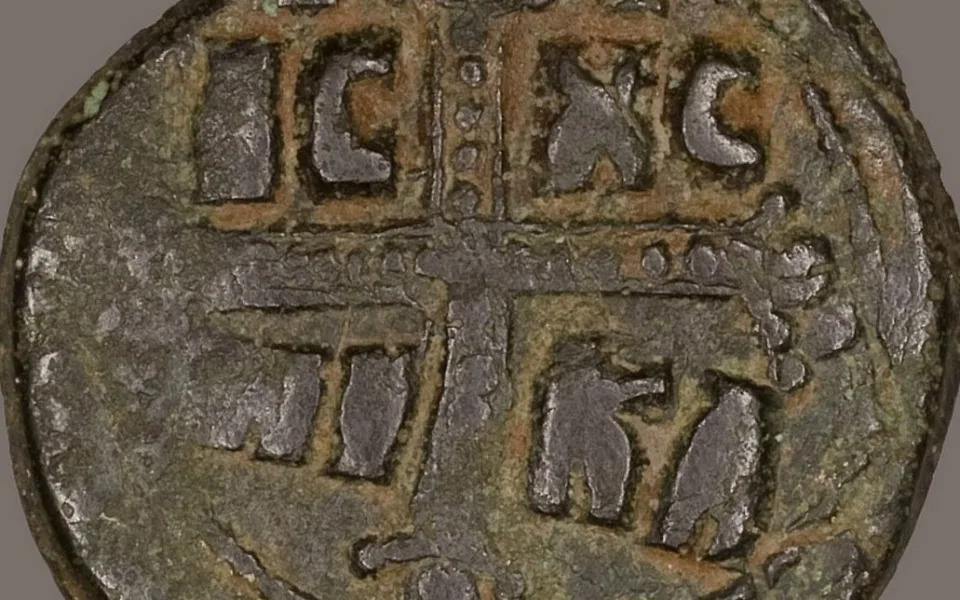Sacred Mysteries: ‘Christus vincit’ and the coming of Christmas
Christopher Howse
Sat, 9 December 2023

IC XC NI KA – detail of a coin of Empress Theodora, 1055 - agefotostock / Alamy
Why were discs of bread that were prepared for the Mass stamped in relief with letters such as IC XC NI KA? That is a question which a once-popular theologian Honorius of Autun attempted to answer in the early 12th century in his commentary on the symbolism of the liturgy.
It was, he suggested, because Christ was the denarius or coin give to the labourers in the vineyard (Matthew, chapter 20). So it was fitting for the host to be stamped with his name just as a coin is stamped with that of the Emperor.
Historically, Honorius got it round the wrong way. Leavened bread prepared for the liturgy in Eastern Christendom had since the 5th century been stamped with those Greek letters, standing for “Jesus Christ Conquers”. This monogram on the bread to be used in the liturgy, was then adopted on coinage. Such coins continued in circulation in the West in areas under Byzantine influence, such as the Norman kingdom of Sicily. In the West, the practice then went full circle, with the monogram copied from coinage and stamped on hosts of unleavened bread.
This scrap of learning from the byways of sigillography appears in a classic study by Ernst Kantorowicz called Laudes Regiae, published in 1946 after delays brought on by the author having to flee the German Nazis. I consulted this book because I was fascinated by the origin of the church chant, Christus vincit. Christus regnat. Christus imperat, “Christ has conquered. Christ reigns. Christ rules.” It is the Latin equivalent of the Greek Iesous Christos Nika expressed as IC XC NIKA.
The Latin chant is used at Easter and at the modern feast of Christ the King, but it also fits the theme of the coming Kingdom of God, which is explored in the present season of Advent. As the Lord’s Prayer says: Adveniat regnum tuum, “Thy kingdom come.”
I had no idea until this year that Christus vincit. Christus regnat. Christus imperat was so old. It was certainly in use before the coronation of Charlemagne, which every schoolboy can tell us was on Christmas Day in the year 800.
The chant, known as the Laudes Regiæ, was used at the coronation of William the Conqueror’s wife Matilda as Queen in 1068. It stayed part of the English coronation tradition until the Reformation, and indeed there is an echo of it still in the coronation acclamation “Vivat!” That interpolation in Psalm 122 (“I was glad”) has been made by boys of Westminster School since the coronation of James II. But on the title page of Cranmer’s Bible of 1539, Henry VIII hands the Bible to the Archbishop while the people around cry Vivat Rex! (The captions are all in Latin on this frontispiece of the Bible in English.) That hope or prayer for a long life for the sovereign was present in some medieval texts of the Laudes Regiae. in the form Vita (such as “Gelasius vita!”)
The Laudes Regiae was far more often in use on great feast days such as Easter, Christmas, the Epiphany or the Ascension than at infrequent coronations. Indeed it as been suggested that coronations picked up the use of the hymn because they often took place on holy days such as Christmas or the Epiphany.
IN structure the hymn is a kind of litany. In other words it calls on God to bless the pope, king, bishop and clergy, and sometimes the army, and it calls on the names of a succession of saints to pray for them. Formally the invocations were sung out and a choir responded.
Fundamentally, the hymn, introduced to England by the Normans, praises God as King.
No comments:
Post a Comment